Dacia is competing in the Dakar Rally with the Sandrider for the first time – The car was developed with the support of Prodrive – The technical details of the new vehicle
With Dacia, a new brand is taking on the Dakar Rally. The program was set up on a large scale from the outset. Three Sandriders will be at the start in Saudi Arabia. Nasser Al-Attiyah, the reigning rally raid world champion, will drive the car with the starting number 200. Sebastien Loeb will be in the car with the starting number 219 and Cristina Gutierrez will drive the 212.
The Sandrider was developed in cooperation with the British rally team Prodrive. The experiences of the past years with the Hunter have been incorporated into the development. Tire damage was the major weakness of this “old” car.
That is why the wheel suspensions were completely redesigned. The entire area around the wheels is also new. The exhaust system was also relocated a bit, because in the Hunter, the exhaust gases heated the tires, which was an additional problem.
The Sandrider is powered by a V6 engine with three liters displacement. There are two turbochargers and direct fuel injection. Dacia states a power output of 265 kW (about 360 hp). The peak torque of 539 Nm is available at 4,250 rpm.
The engine is based on the Nissan Z. Synthetic fuel from Aramco is used. The tank holds 560 liters, which means that a daily stage can be completed without a refueling stop. According to the T1+ regulations, the minimum weight is 2,010 kilograms.
A sequential six-speed transmission is standard, as with the competition. Prodrive relies on Reiger dampers. The visibility for the driver and co-driver has also been improved compared to the Hunter.
There is air conditioning for the driver in the cockpit. Heat-reflecting materials are also used. The Sandrider is also the first vehicle to have dampers on the seats to prevent back injuries in the event of a rollover or hard landing.
It is an all-wheel-drive vehicle. The Dacia is 4,140 millimeters long, 2,290 millimeters wide and 1,810 millimeters high. The wheelbase is three meters. According to the regulations, a maximum suspension travel of 350 millimeters is allowed.
The chassis consists of a tubular steel trellis frame. The fairing is made of carbon. As with the competition, attention was paid to the aerodynamics in order to reduce drag and reach the limited top speed of 170 km/h more quickly.
One-two victory at the Morocco Rally
After an initial shakedown and first tests in Wales and the south of France, the big test program started in June. There were three test dates in Morocco, each lasting between six and eight days.
Each day, between 400 and 500 kilometers were covered with each of the three crews. Finally, the first competitive event took place at the beginning of October at the Morocco Rally. It was a complete success. Dacia won three of the five stages.
Al-Attiyah won the rally five minutes before Loeb. “No one can appreciate how much tireless effort was needed to get three cars to the start of the Morocco Rally,” reflects team manager Tiphanie Isnard.
“But this was only our first event. A test for the Dakar. So it’s a result we couldn’t have hoped for. Now it’s important that we keep our feet on the ground, because this is just the beginning of our adventure.”
“We have a big task ahead of us because we learned a lot during this race. There are some things we need to improve because the Dakar is such a tough race. But we are all super happy with the result in Morocco.”





